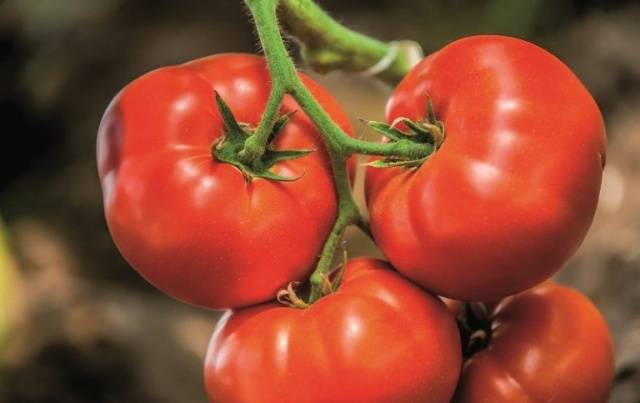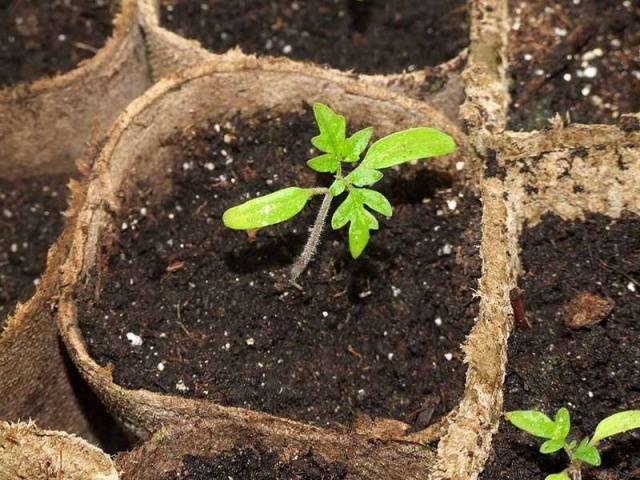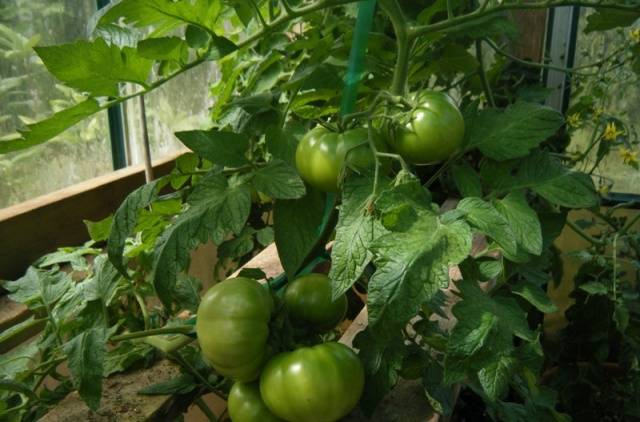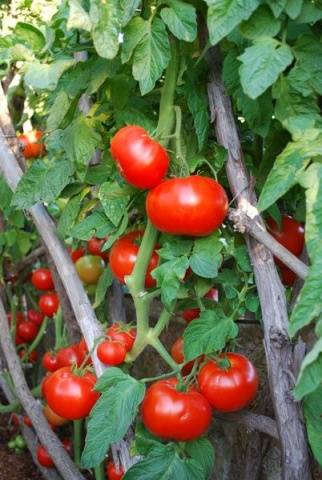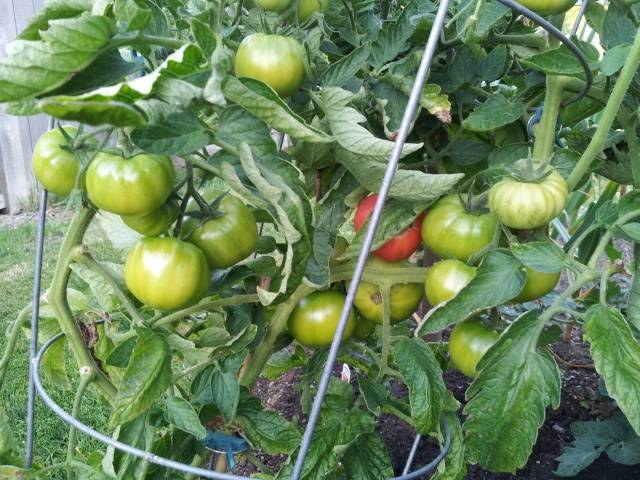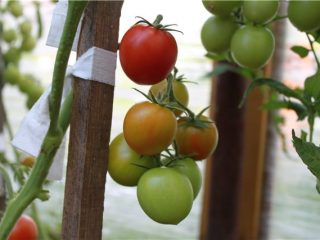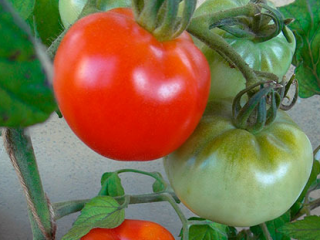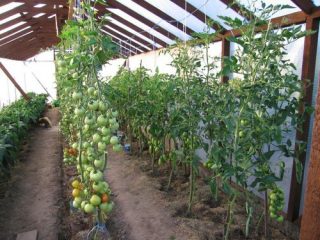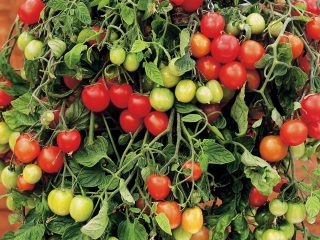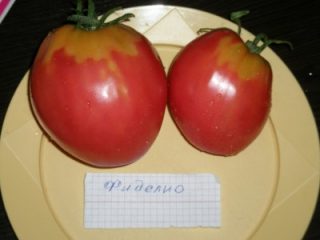Content
Tomato Big Beef is an early variety developed by Dutch scientists. The variety is valued for its excellent taste, resistance to diseases, temperature changes and other unfavorable conditions. Plants need constant care, including watering and feeding.
Botanical description
Characteristics of Big Beef tomatoes:
- early maturation;
- the period from germination to harvest is 99 days;
- powerful sprawling bush;
- a large number of leaves;
- height up to 1.8 m;
- 4-5 tomatoes are formed on the brush;
- indeterminate grade.
The Big Beef variety is characterized by the following:
- rounded shape;
- smooth surface;
- the mass of tomatoes is from 150 to 250 g;
- good taste;
- juicy fleshy pulp;
- number of cameras - from 6;
- high concentration of dry substances.
The Big Beef variety belongs to steak tomatoes, which are distinguished by their large size and excellent taste. In the United States, they are used to make hamburgers.
Up to 4.5 kg of tomatoes are harvested from one bush. The fruits are suitable for a daily diet, fresh or cooked. In home canning, the fruits are processed into tomato juice or paste.
Big Beef tomatoes have a long shelf life. The fruits endure long transportation and are suitable for growing for sale.
Seedlings of tomatoes
Big Beef tomatoes are grown in seedlings. At home, seeds are planted. After their germination, the tomatoes are provided with the necessary conditions.
Preparing for landing
Planting work is performed in February or March. The soil for tomatoes is prepared in the fall by combining in equal proportions of garden soil and humus. The substrate is also obtained by mixing peat, sawdust and sod land in a ratio of 7: 1: 1.
The soil is placed in an oven or microwave oven for 10-15 minutes for disinfection. In frosty weather, it is exposed to the street or balcony.
Big Beef tomatoes are planted in boxes or separate cups. First, the containers are filled with soil, the seeds are placed on top with an interval of 2 cm and 1 cm of peat is poured. When using peat tablets or cups, picking is not required for seedlings.
The containers with tomatoes are covered with glass or foil, then left in a warm room. At temperatures above 25 ° C, tomato sprouts will appear in 3-4 days.
Seedling care
Seedling tomatoes need constant care. They are provided with a temperature of 20-26 ° C during the daytime and 15-18 ° C at night.
The room with tomatoes is regularly ventilated, but the plants are protected from drafts. If necessary, phytolamps are installed so that the tomatoes receive lighting for half a day.
If the tomatoes were planted in boxes, then the seedlings dive when 5-6 leaves appear. Plants are distributed in separate containers. The use of peat tablets or cups allows you to avoid picking.
Before planting tomatoes in a permanent place, they are hardened in the fresh air. At first, the period of their stay on the balcony or loggia is 2 hours. This period is gradually increased. Immediately before planting, tomatoes are kept in natural conditions for a day.
Landing in the ground
The Big Beef tomatoes are transferred to the greenhouse or to the open beds.Indoors, a higher yield is obtained.
Tomatoes with a height of 30 cm, having 7-8 leaves, are subject to planting. Such plants are characterized by a developed root system, so they are able to withstand changes in external conditions.
The place for tomatoes is chosen taking into account the culture that grew on it. Tomatoes are planted after cabbage, onions, carrots, beets, legumes.
The soil for tomatoes is prepared in the fall. The beds are dug up and fertilized with humus. In the spring, deep loosening of the soil is performed.
Tomato variety Big Beef F1 is planted at a distance of 30 cm from each other. When organizing several rows, 70 cm is left.
Tomatoes are transferred together with a lump of earth into a prepared hole. The roots of the plants are covered with earth, which is slightly compacted. The plantings are watered abundantly and tied to a support.
Tomato care
According to reviews, Big Beef tomatoes bring a high yield with constant care. Plants need watering, feeding, pinching stepchildren. For the prevention of diseases and the spread of pests, plantings are treated with ready-made preparations or folk remedies.
Watering plants
Tomatoes Big Beef F1 are watered weekly. For irrigation, they take settled warm water, which is brought under the root of the plants.
The intensity of watering depends on the stage of development of the tomatoes. Before flowering, they are watered every week using 5 liters of water. When flowering begins, moisture is applied every 3 days, the watering rate is 3 liters.
After watering, be sure to loosen the soil under the tomatoes to improve moisture absorption. It is important to regularly ventilate the greenhouse and avoid crusting on the ground.
Fertilization
During the season, tomatoes are fed 3-4 times. Fertilizer is applied as a solution or embedded in the soil in a dry form.
The feeding scheme includes several stages:
- For the first treatment, a mullein solution is prepared in a ratio of 1:10. Fertilizer saturates tomatoes with nitrogen necessary for growing green mass. In the future, it is better to refuse the use of such dressings in order to avoid the increased density of tomato leaves.
- The next treatment is performed after 2-3 weeks. A large bucket of water requires 20 g of superphosphate and potassium salt each. Fertilizers can be applied directly to the soil. Phosphorus and potassium stimulate plant metabolism and improve the taste of fruits.
- During flowering, a boric acid solution is obtained, consisting of 2 g of the substance and 2 liters of water. Tomatoes are processed on a leaf to stimulate the formation of ovaries.
- During fruiting, tomatoes are re-fed with phosphorus and potassium fertilizers.
An alternative option is to use natural fertilizers. The complex of nutrients contains wood ash. It is buried in the ground or used to obtain infusion.
Bush formation
Big Beef tomatoes form into 1 stem. Stepchildren growing from the leaf sinus are pinched weekly.
The formation of a bush allows for a high yield and prevents thickening. 7-8 brushes are left on the plants. At the top, the tomatoes are tied to a support.
Disease and pest control
The Big Beef variety is resistant to viral diseases of tomatoes. Plants are not subject to fusaoriasis, verticilliasis, cladosporia, tobacco mosaic. Viral diseases are the most dangerous for tomatoes because they have no cure. Affected plants must be destroyed.
With high humidity, fungal diseases develop on tomatoes. The disease can be determined by the presence of dark spots on the fruits, stems and tops of tomatoes. To combat fungal infections, Bordeaux liquid and copper-based preparations are used.
Tomatoes attract bear, aphids, gall midges, whiteflies and other pests. For insects, insecticides or folk remedies are used (infusions with onion peels, soda, wood ash).
Gardeners reviews
Conclusion
Big Beef tomatoes are grown for their fleshy, tasty fruit. Bushes are powerful and vigorous, need shaping and tying. The variety is suitable for growing in unfavorable conditions. It is planted under a glazed or film shelter.
